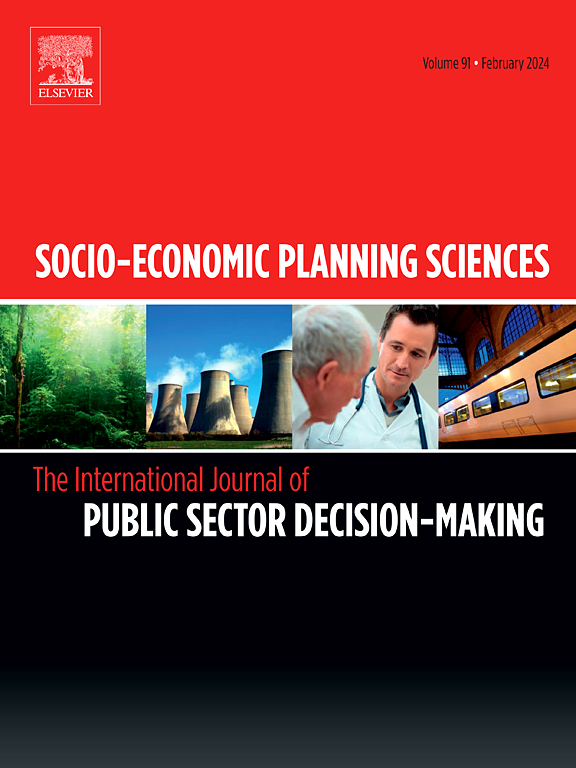新兴电网基础设施运营的绩效评估:来自中国超高压输电线路的证据
IF 5.4
2区 经济学
Q1 ECONOMICS
引用次数: 0
摘要
新兴的电力基础设施,特别是电网基础设施,对于电力部门应对极端冲击和向清洁能源过渡越来越重要。然而,将系统稳定性指标纳入这种新型基础设施的评估框架的研究有限。本研究以中国的特高压(UHV)线路为例,探讨在特高压线路上投入大量的人力和资金是否会带来令人满意的服务可靠性和其他回报。特高压线路是一项重要的新型基础设施。利用2005年至2022年中国省级均衡面板数据,我们采用非径向定向距离函数(NDDF)模型结合差分法(DID)方法来评估特高压项目对电网企业全要素生产率(TFP)的影响。研究结果表明,特高压项目显著改善了公用事业绩效,以TFP衡量,平均提高了1.07%。机制分析表明,尽管特高压项目对能源转型的贡献在短期内无法显现,但资源配置效应和能源替代效应对TFP的促进作用都是显著的。特高压的好处在电力需求高的地区和电力输入端的公司尤为显著。这些发现表明,规划者应该采用一种长期的、针对具体情况的方法来发展电力基础设施。鉴于能源转型是一个渐进的过程,作为关键推动者的电网公司必须有效应对转型阶段的挑战,以确保未来的能源可持续发展。本文章由计算机程序翻译,如有差异,请以英文原文为准。
Performance evaluation of emerging grid infrastructure Operations: Evidence from ultra-high-voltage transmission lines in China
Emerging electrical infrastructure, especially network infrastructure, is increasingly important for the electricity sector to respond to extreme shocks and transition to clean energy. However, limited research has included system stability indicators into the evaluation framework of this new infrastructure. This study takes the example of ultra-high-voltage (UHV) lines in China, a key new infrastructure, to explore whether the substantial investment in labor and capital of UHV lines will lead to satisfactory service reliability and other returns. Using province-level balanced panel data from 2005 to 2022 in China, we apply the non-radial directional distance function (NDDF) model combined with a difference-in-differences (DID) approach to assess how UHV projects influence the total factor productivity (TFP) of grid firms. The findings reveal that UHV projects lead to a notable improvement in utility performance, as measured by TFP, with an average increase of 1.07 %. Mechanism analysis shows that the resource allocation and energy substitution effects are both significant for facilitating TFP, although the contribution of UHV projects to energy transition cannot manifest in the short term. The benefits of UHV are particularly significant in regions with high demand for electricity and at firms on the electricity input end. These findings suggest that planners should adopt a long-term, context-specific approach to the development of electrical infrastructure. Given that the energy transition is a gradual process, grid utilities, as key enablers, must effectively address the challenges of the transitional phase to ensure a future with sustainable energy.
求助全文
通过发布文献求助,成功后即可免费获取论文全文。
去求助
来源期刊

Socio-economic Planning Sciences
OPERATIONS RESEARCH & MANAGEMENT SCIENCE-
CiteScore
9.40
自引率
13.10%
发文量
294
审稿时长
58 days
期刊介绍:
Studies directed toward the more effective utilization of existing resources, e.g. mathematical programming models of health care delivery systems with relevance to more effective program design; systems analysis of fire outbreaks and its relevance to the location of fire stations; statistical analysis of the efficiency of a developing country economy or industry.
Studies relating to the interaction of various segments of society and technology, e.g. the effects of government health policies on the utilization and design of hospital facilities; the relationship between housing density and the demands on public transportation or other service facilities: patterns and implications of urban development and air or water pollution.
Studies devoted to the anticipations of and response to future needs for social, health and other human services, e.g. the relationship between industrial growth and the development of educational resources in affected areas; investigation of future demands for material and child health resources in a developing country; design of effective recycling in an urban setting.
 求助内容:
求助内容: 应助结果提醒方式:
应助结果提醒方式:


